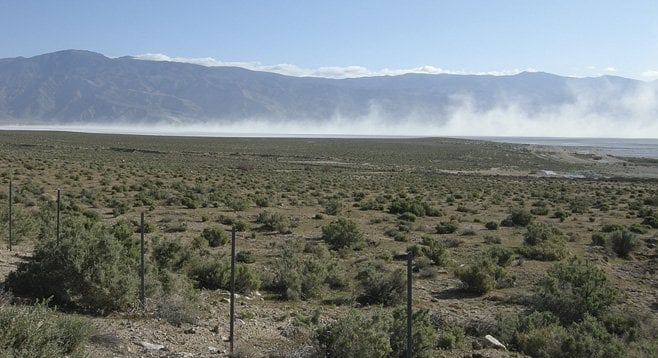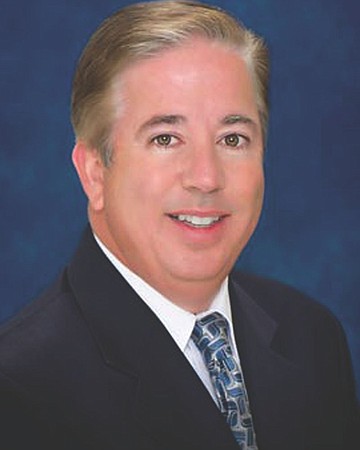 Facebook
Facebook
 X
X
 Instagram
Instagram
 TikTok
TikTok
 Youtube
Youtube

The San Diego County Water Authority is glowering at the north when it should be warily eyeing the east. The authority, which wholesales water to county water districts, is spending piles of money on a lawsuit against the Los Angeles–based Metropolitan Water District of Southern California, which provides water to communities throughout the Southland. The San Diego County Water Authority, a customer of Metropolitan, thinks it is being overcharged.
But the county water authority should be pondering what is going on in Imperial Valley. In 2003, the authority and the Imperial Irrigation District cut a deal permitting San Diego to import water from the valley. That water now accounts for 27 percent of San Diego County usage.
Until just recently, only two members of the five-person Imperial Irrigation District board were skeptical of the 2003 arrangement. But one member has resigned suddenly, and the June 5 election results suggest that, after the final November runoff vote, the skeptics could have four or five of the five votes. Such a new balance could significantly alter the thrust of the deal and force the San Diego County Water Authority to face reality about the availability of water and the need for conservation.

That 2003 contract must be renegotiated or it will “shipwreck our economy,” says James Hanks, a current member of the Imperial Irrigation District board. “There is a rebellion going on down here. The contract with San Diego is harming our agricultural industry” greatly because farmers say they can’t get adequate water. “Our economic engine is agriculture. Without that, we are dead.”
Indeed, Imperial Valley citizens increasingly call their homeland “Owens Valley,” the eastern California area whose water was filched by Los Angeles, as farmers were underpaid for land. One result was the infamous California Water Wars. A second result was the frightening windblown dust polluting the air after Owens Lake dried up.
If the contract with San Diego can’t be altered to give relief to Imperial Valley, “it will bankrupt the [Imperial Irrigation District] and bankrupt Imperial Valley and create another Owens Valley,” says Steve Scaroni, a third-generation valley farmer.
One critical question is whether the State of California will handle rehabilitation of the Salton Sea. The matter has been considered at the trial and appellate court levels. The California Supreme Court won’t take it up. The case is now back at the superior court level, and court watchers think the final decision may let the state off the hook.
The sea is shrinking every year, and the transfer of water to San Diego cuts off agricultural runoff that should replenish it. The sea’s shrinkage exposes mud- and salt flats, whose fine particulates and pesticide residues are carried aloft by the wind and distributed over the region. The result is “increasing numbers of kids going to hospitals for asthma,” among other health woes, says Stuart Hurlbert, professor emeritus of biology at San Diego State. The Salton Sea could be Owens Lake redux.
Hurlbert thinks the state will gladly back out of its obligation. That would leave the Salton Sea rehabilitation job largely to the Imperial Irrigation District, which can’t afford it. Last year, the district hired Charles DuMars, a New Mexico expert in water law, to study the situation. “If the state fails to cover the environmental and social costs to the Imperial Valley as a result of the decline in the Salton Sea,” DuMars wrote, the partners in the big water transfer, including San Diego, “must shoulder that additional burden.”
Wrote DuMars, “Failure to properly address the Salton Sea issues could contribute to the destruction of the health, quality of life, and economic base of the valley.” Hurlbert says the rehabilitation could be done cheaply if the water stayed in the valley.
Hanks belongs to the 54950 Commission, an activist group that rides herd on local government. The commission recently came out with a report concluding that the irrigation district “has come to be governed under a system of ‘adverse domination,’ in which private interests mostly outside Imperial Valley benefit at the expense of the Imperial Valley.”
The report notes that San Diego attorney David Osias is the lawyer for the irrigation district and is managing partner of the firm Allen Matkins, which specializes in real estate. Osias has given the Imperial irrigation district bad advice that has been a boon for San Diego real estate developers, say Hanks and Scaroni. In turn, the San Diego County Water Authority “is dominated by the real estate industry,” says Hurlbert.
“We’re just a pimple on [Osias’s] butt compared to his clients [in San Diego],” says Hanks. In counting on the state to pick up the tab for Salton Sea rehabilitation, “our lawyers blew it. We can’t afford to mitigate.”
In effect, the water needs of San Diego developers are dictating Imperial Valley policy, says San Diego attorney Mike Aguirre, a co-author of the 54950 Commission report. “The [San Diego] developers want to develop but not pay for infrastructure needed to support the development,” says Aguirre.

Osias says Scaroni and his friends are orchestrating “a smear campaign” to oust two Imperial Irrigation District directors. Lawsuits by Scaroni and fellow farmers against the district have lost consistently. Osias says it is “nonsense” that he is working on behalf of San Diego developers. “There is no reason to think that the state will not meet its binding contractual obligation [on Salton Sea rehabilitation].”
Dennis Cushman, assistant general manager of the San Diego County Water Authority, does not anticipate that the authority will have to share in the Salton Sea rehabilitation cost. “We work to press the state to fulfill its commitment,” he says.
But, says University of California San Diego political scientist Steve Erie, “There is a time bomb called the Salton Sea. The environmental problems of the Salton Sea make the drying up of Owens Lake look like a walk in the park. It will blow up the [water transfer deal], and the mitigation costs will be piled on San Diego ratepayers.” ■


The San Diego County Water Authority is glowering at the north when it should be warily eyeing the east. The authority, which wholesales water to county water districts, is spending piles of money on a lawsuit against the Los Angeles–based Metropolitan Water District of Southern California, which provides water to communities throughout the Southland. The San Diego County Water Authority, a customer of Metropolitan, thinks it is being overcharged.
But the county water authority should be pondering what is going on in Imperial Valley. In 2003, the authority and the Imperial Irrigation District cut a deal permitting San Diego to import water from the valley. That water now accounts for 27 percent of San Diego County usage.
Until just recently, only two members of the five-person Imperial Irrigation District board were skeptical of the 2003 arrangement. But one member has resigned suddenly, and the June 5 election results suggest that, after the final November runoff vote, the skeptics could have four or five of the five votes. Such a new balance could significantly alter the thrust of the deal and force the San Diego County Water Authority to face reality about the availability of water and the need for conservation.

That 2003 contract must be renegotiated or it will “shipwreck our economy,” says James Hanks, a current member of the Imperial Irrigation District board. “There is a rebellion going on down here. The contract with San Diego is harming our agricultural industry” greatly because farmers say they can’t get adequate water. “Our economic engine is agriculture. Without that, we are dead.”
Indeed, Imperial Valley citizens increasingly call their homeland “Owens Valley,” the eastern California area whose water was filched by Los Angeles, as farmers were underpaid for land. One result was the infamous California Water Wars. A second result was the frightening windblown dust polluting the air after Owens Lake dried up.
If the contract with San Diego can’t be altered to give relief to Imperial Valley, “it will bankrupt the [Imperial Irrigation District] and bankrupt Imperial Valley and create another Owens Valley,” says Steve Scaroni, a third-generation valley farmer.
One critical question is whether the State of California will handle rehabilitation of the Salton Sea. The matter has been considered at the trial and appellate court levels. The California Supreme Court won’t take it up. The case is now back at the superior court level, and court watchers think the final decision may let the state off the hook.
The sea is shrinking every year, and the transfer of water to San Diego cuts off agricultural runoff that should replenish it. The sea’s shrinkage exposes mud- and salt flats, whose fine particulates and pesticide residues are carried aloft by the wind and distributed over the region. The result is “increasing numbers of kids going to hospitals for asthma,” among other health woes, says Stuart Hurlbert, professor emeritus of biology at San Diego State. The Salton Sea could be Owens Lake redux.
Hurlbert thinks the state will gladly back out of its obligation. That would leave the Salton Sea rehabilitation job largely to the Imperial Irrigation District, which can’t afford it. Last year, the district hired Charles DuMars, a New Mexico expert in water law, to study the situation. “If the state fails to cover the environmental and social costs to the Imperial Valley as a result of the decline in the Salton Sea,” DuMars wrote, the partners in the big water transfer, including San Diego, “must shoulder that additional burden.”
Wrote DuMars, “Failure to properly address the Salton Sea issues could contribute to the destruction of the health, quality of life, and economic base of the valley.” Hurlbert says the rehabilitation could be done cheaply if the water stayed in the valley.
Hanks belongs to the 54950 Commission, an activist group that rides herd on local government. The commission recently came out with a report concluding that the irrigation district “has come to be governed under a system of ‘adverse domination,’ in which private interests mostly outside Imperial Valley benefit at the expense of the Imperial Valley.”
The report notes that San Diego attorney David Osias is the lawyer for the irrigation district and is managing partner of the firm Allen Matkins, which specializes in real estate. Osias has given the Imperial irrigation district bad advice that has been a boon for San Diego real estate developers, say Hanks and Scaroni. In turn, the San Diego County Water Authority “is dominated by the real estate industry,” says Hurlbert.
“We’re just a pimple on [Osias’s] butt compared to his clients [in San Diego],” says Hanks. In counting on the state to pick up the tab for Salton Sea rehabilitation, “our lawyers blew it. We can’t afford to mitigate.”
In effect, the water needs of San Diego developers are dictating Imperial Valley policy, says San Diego attorney Mike Aguirre, a co-author of the 54950 Commission report. “The [San Diego] developers want to develop but not pay for infrastructure needed to support the development,” says Aguirre.

Osias says Scaroni and his friends are orchestrating “a smear campaign” to oust two Imperial Irrigation District directors. Lawsuits by Scaroni and fellow farmers against the district have lost consistently. Osias says it is “nonsense” that he is working on behalf of San Diego developers. “There is no reason to think that the state will not meet its binding contractual obligation [on Salton Sea rehabilitation].”
Dennis Cushman, assistant general manager of the San Diego County Water Authority, does not anticipate that the authority will have to share in the Salton Sea rehabilitation cost. “We work to press the state to fulfill its commitment,” he says.
But, says University of California San Diego political scientist Steve Erie, “There is a time bomb called the Salton Sea. The environmental problems of the Salton Sea make the drying up of Owens Lake look like a walk in the park. It will blow up the [water transfer deal], and the mitigation costs will be piled on San Diego ratepayers.” ■
Comments